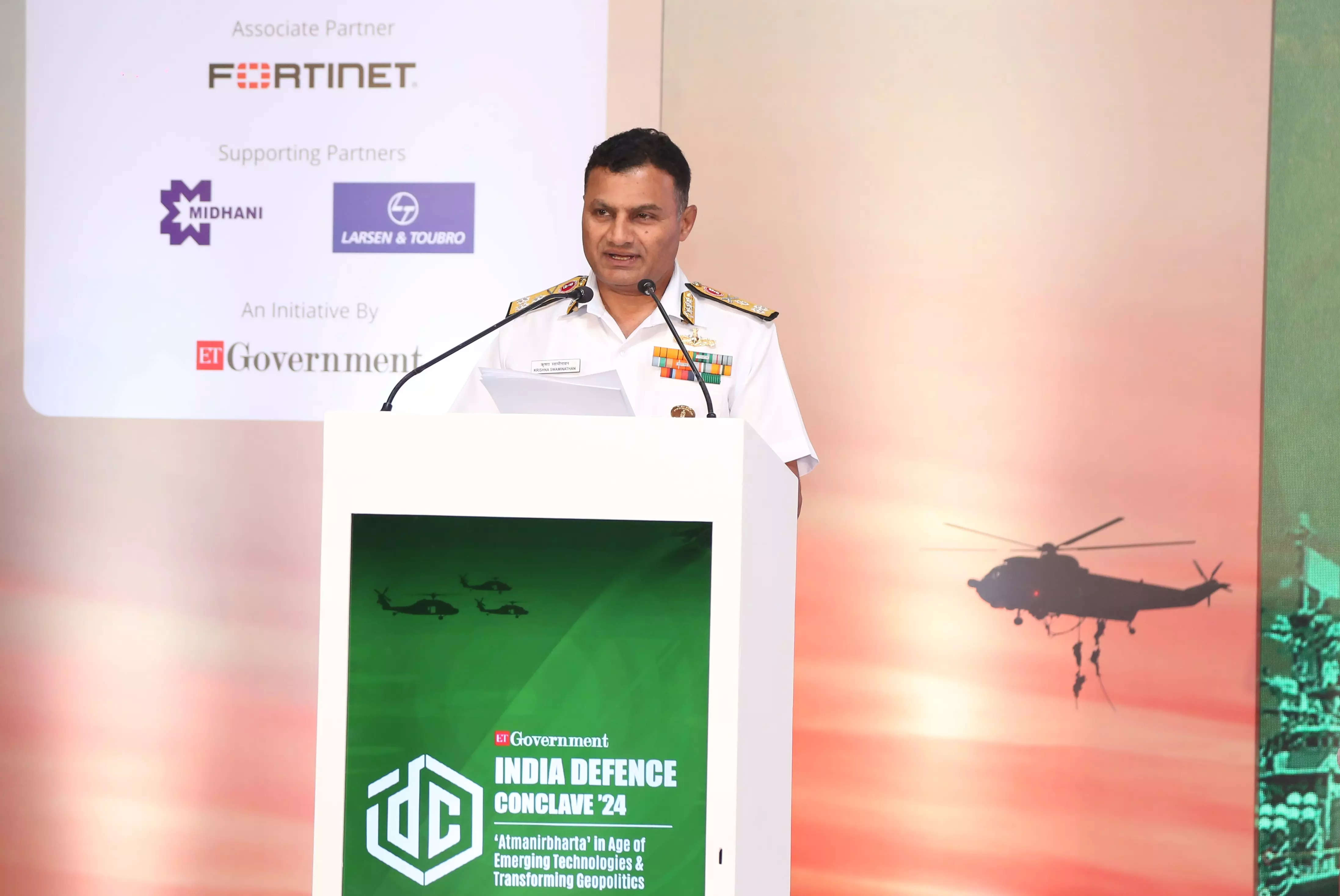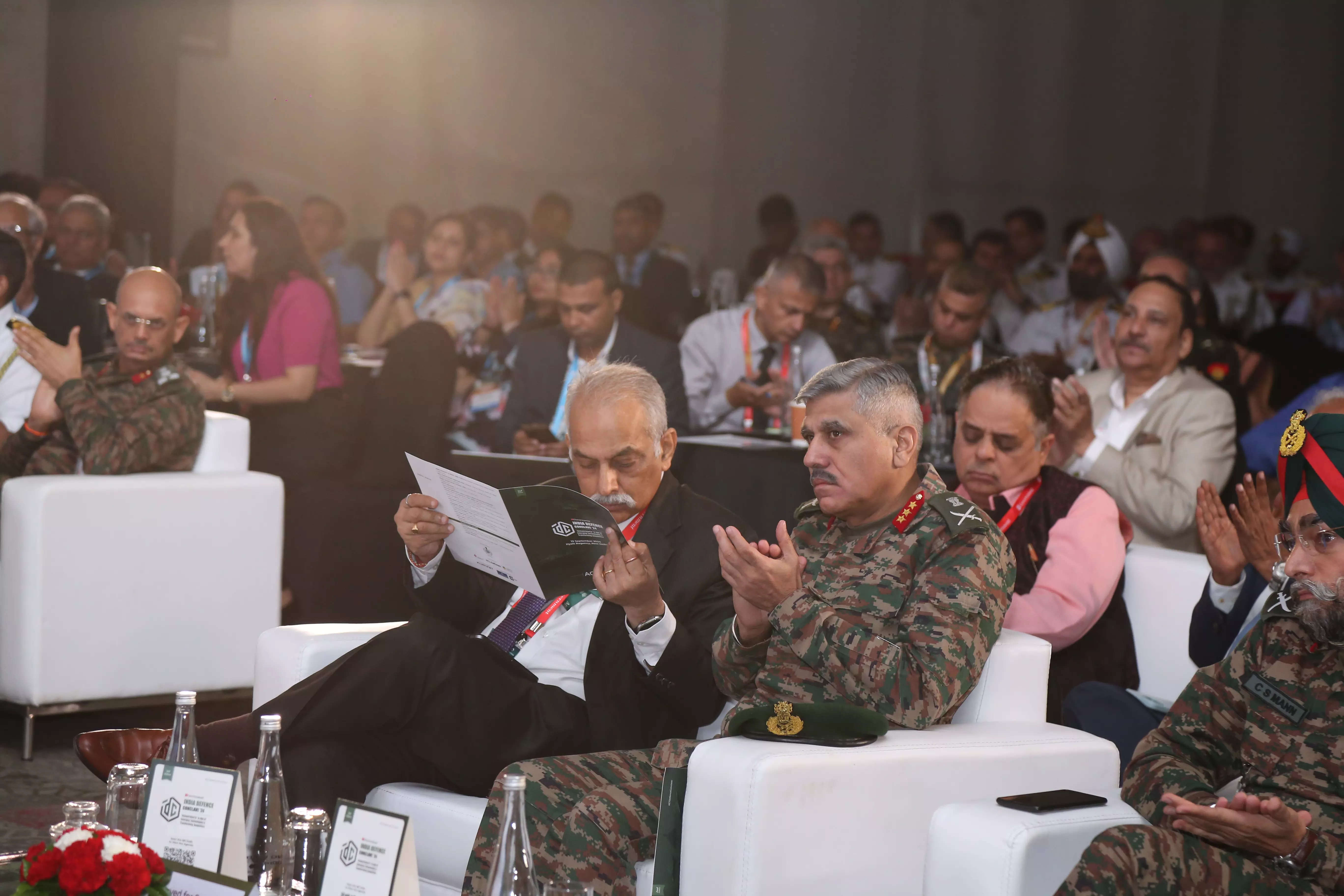
Atmanirbharta in defence had its moment on September 13, when the 2nd edition of the India Defence Conclave was organized at Hyatt Regency in New Delhi.
The Conclave was attended by top officials from the Ministry of Defence, including the three services (Army, Navy and Air Force) and the DRDO, and diplomats from friendly countries, members of important defence think tanks, university professors and other stakeholders in the nation’s defence ecosystem.
The Vice Chief of the Naval Staff, Vice Admiral Krishna Swaminathan, AVSM, VSM, delivered the keynote address on the topic of ‘Technological transformation of the Indian Navy in the Coming Decade’.
He began his address by noting that rapid advancements in technology and the democratization of high tech applications and tools have bridged the asymmetry in conventional capabilities between bigger and smaller nations. New and emerging fields such as hypersonics, artificial intelligence, the Internet of Things, advanced material manufacturing, space technology, quantum computing, robotics and autonomous vessels have become available to all parties.
“A wide array of such options are available off the shelf at relatively affordable prices. These could be deployed seamlessly across military and civil domains to target domestic infrastructure, financial systems, cyber services and communication networks. Accelerated progress in niche and disruptive technologies has catalyzed a transformation in the character and the conduct of wars,” the Vice Chief said.
He pointed out to the audience that the evolution of war from its classic sense of being purely a military activity to becoming a multi domain, national endeavor, has led to a blurring of the distinction between peace and war, civil and military, public and private, real and virtual and legitimate and illegitimate. “All this is obvious in the violence and conflicts that we see across the world, whether in the Russia-Ukraine war or in the Gaza war,” he said.
“Cyber and digital media are being employed increasingly to fuel systematic disinformation so as to shape the narrative and target the adversary globally, much further from the national boundaries. For us, therefore, in the profession of arms, continuous and holistic assessment of the changing character of war and warfare and adoption of mitigating and leveraging technologies and strategies has never been more important than it is today.”
“How is India poised in these transformational times? Why should the ordinary Indian be concerned about the changing tech space and the evolving nature of warfare? Let me try and connect these dots for you. Statistically speaking, India’s GDP today is about $3.94 trillion. We aim to become a $30 trillion economy by 2047–this is a nearly eight fold increase.”
Reflecting on the role that the Indian Navy is playing in protecting India’s maritime trade, Vice Admiral Krishna Swaminathan said, “An export enabled economy will be the prime mover for us to achieve our national vision of Viksit Bharat@ 2047. It might be of interest to all of you that 95% of India’s trade by volume is being conducted through the sea.”
“This should make it clear that for the national economy to thrive, access to ports and secure seas is critical. India’s expanding economy depends on our national interests remaining safe, secure and protected across a significantly wider geography than ever before, and all of that is accessible, largely through the oceans,” he added.
He emphasized that national power and economic progress depend today on the security of maritime trade, which is protected by a strong Navy. “A symbiotic relationship between economic strength and maritime power is established as a fundamental tenet of international relations. We know that this was exercised by the renowned Chola kingdom as early as the 10th and 11th centuries,” he said.
“The concept was popularized in the 19th century by the American strategist Alfred Thayer Mahan. Since then this has been the philosophy by which modern nations have perceived the role and relevance of the Navy. A strong Navy is a prerequisite for safeguarding national economic interests, for fostering trade in commerce and attracting investments in the country.”
“The point I am trying to make is that an aspirational India needs a credible and capable Navy for realizing the dream of becoming a developed nation by 2047. We cannot afford to be dependent on external forces for meeting our security security requirements. Atmanirbharta in defense is now not just an economic imperative, it is also a strategic necessity. I must clarify that this is not just my view, it is the policy of the Government of India.”
“There is therefore a concerted focus in the Indian Navy to synergize its efforts with other government agencies, the scientific community, independent researchers, the academia, the industry and friendly foreign countries to achieve self reliance in core technologies and also plug the gap in niche and disruptive technologies. Our aim is to seamlessly merge the elements of innovation, indigenization and self reliance to create self sufficiency.”
“The Indian Navy’s quest for Atmanirbharata is not new. As you would know, the Indian Navy championed self-reliance in domestic warship building over six decades ago with our first indigenous warship INS Ajay. Since then the Indian Navy has been spearheading the building of ships. Today we possess the capability to design, build and operate all kinds of warships and submarines, including complex platforms like aircraft carriers and nuclear submarines.”
“Our transition from being a buyer’s Navy to becoming a builder’s Navy is not only supporting the preparedness of the defence ecosystem, it is also spurring economic and industrial growth. For instance, INS Vikram, India’s first indigenously built aircraft carrier, has engaged about 500 MSMEs and created employment for over 12,000 people from all kinds of ancillary industry.”
“In addition, of course, to the 2000 shipyard personnel that were involved in this construction. Estimates show that every rupee spent on shipbuilding triggers the circulation of INR 1.82 rupees. This plow back into the society in the form of employment and growth of ancillary industry.”
“The defence related orders enable the growth of an ecosystem of technology development, scientific research and collaboration among investors, designers, manufacturers, and skilled workers. To put this in perspective, and I say this merely to illustrate the point, the Indian Navy’s current order book of nearly INR 1.5 lakh crore will result in the circulation of almost INR 2.73 lakh crore in India’s shipbuilding sector.”
“Looking into the future, our aim is to create a well-balanced, multi-dimensional force that is capable of delivering ordinance on target and having an impact across the full spectrum of conflict. We will continue to acquire and expand our blue water capabilities. We are working to ensure that the aircraft carriers are suitably supplemented by the next generation destroyers and frigates to protect force and offensive action.”
Vice Admiral Krishna Swaminathan ended his address by pointing out that India is the only nation in the world to have an ocean named after it, and it is the duty of the Indian Navy to ensure the security of this ocean and the national maritime interests that are dependent on it.
“We are ready to face every challenge. We are doing our best to strengthen ourselves, transform our capabilities and provide maritime security to the nation, and safeguard the national interests anywhere, anytime and anyhow,” he said.




